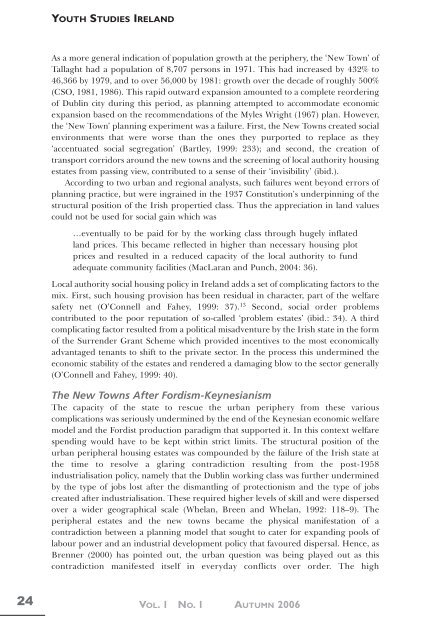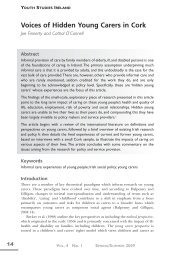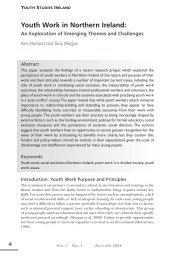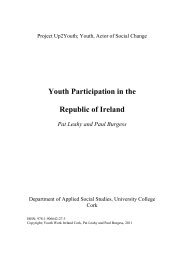Download full edition - Youth Work Ireland
Download full edition - Youth Work Ireland
Download full edition - Youth Work Ireland
You also want an ePaper? Increase the reach of your titles
YUMPU automatically turns print PDFs into web optimized ePapers that Google loves.
YOUTH STUDIES IRELANDAs a more general indication of population growth at the periphery, the ‘New Town’ ofTallaght had a population of 8,707 persons in 1971. This had increased by 432% to46,366 by 1979, and to over 56,000 by 1981: growth over the decade of roughly 500%(CSO, 1981, 1986). This rapid outward expansion amounted to a complete reorderingof Dublin city during this period, as planning attempted to accommodate economicexpansion based on the recommendations of the Myles Wright (1967) plan. However,the ‘New Town’ planning experiment was a failure. First, the New Towns created socialenvironments that were worse than the ones they purported to replace as they‘accentuated social segregation’ (Bartley, 1999: 233); and second, the creation oftransport corridors around the new towns and the screening of local authority housingestates from passing view, contributed to a sense of their ‘invisibility’ (ibid.).According to two urban and regional analysts, such failures went beyond errors ofplanning practice, but were ingrained in the 1937 Constitution’s underpinning of thestructural position of the Irish propertied class. Thus the appreciation in land valuescould not be used for social gain which was…eventually to be paid for by the working class through hugely inflatedland prices. This became reflected in higher than necessary housing plotprices and resulted in a reduced capacity of the local authority to fundadequate community facilities (MacLaran and Punch, 2004: 36).Local authority social housing policy in <strong>Ireland</strong> adds a set of complicating factors to themix. First, such housing provision has been residual in character, part of the welfaresafety net (O’Connell and Fahey, 1999: 37). 13 Second, social order problemscontributed to the poor reputation of so-called ‘problem estates’ (ibid.: 34). A thirdcomplicating factor resulted from a political misadventure by the Irish state in the formof the Surrender Grant Scheme which provided incentives to the most economicallyadvantaged tenants to shift to the private sector. In the process this undermined theeconomic stability of the estates and rendered a damaging blow to the sector generally(O’Connell and Fahey, 1999: 40).The New Towns After Fordism-KeynesianismThe capacity of the state to rescue the urban periphery from these variouscomplications was seriously undermined by the end of the Keynesian economic welfaremodel and the Fordist production paradigm that supported it. In this context welfarespending would have to be kept within strict limits. The structural position of theurban peripheral housing estates was compounded by the failure of the Irish state atthe time to resolve a glaring contradiction resulting from the post-1958industrialisation policy, namely that the Dublin working class was further underminedby the type of jobs lost after the dismantling of protectionism and the type of jobscreated after industrialisation. These required higher levels of skill and were dispersedover a wider geographical scale (Whelan, Breen and Whelan, 1992: 118–9). Theperipheral estates and the new towns became the physical manifestation of acontradiction between a planning model that sought to cater for expanding pools oflabour power and an industrial development policy that favoured dispersal. Hence, asBrenner (2000) has pointed out, the urban question was being played out as thiscontradiction manifested itself in everyday conflicts over order. The high24 VOL. 1 NO. 1 AUTUMN 2006
















